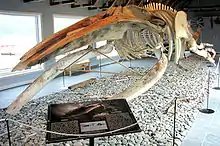King's Point
King's Point is a town on the north shore of the southwest arm of Green Bay in Newfoundland and Labrador, Canada. King's Point is 24 km (15 mi) by road (Route 391) from Springdale, and 10 km (6.2 mi) from the Trans-Canada Highway (Route 1).
King's Point | |
|---|---|
Town | |
| Country | |
| Province | |
| Population (2016) | |
| • Total | 659 |
| Time zone | UTC-3:30 (Newfoundland Time) |
| • Summer (DST) | UTC-2:30 (Newfoundland Daylight) |
| Area code(s) | 709 |
| Highways | |
| Website | www.townofkingspoint.ca |
History
The earliest inhabitants of King's Point were the Maritime Archaic Indians and later the Beothuk Indians. Before the 1860s the area was a source of timber for French fishermen and naval vessels occupying the "French Shore". In the 1860s the first known European settler, James King, established fishing premises and a dwelling on the Point. This is how the community got its name. His dwelling was destroyed by high tides shortly after and abandoned by King.
By 1875, when Alexander Murray (head of the Geological Survey of Newfoundland) did an extensive survey of the area, there were three or four families settled at King's Point. They lived in carved homesteads out of the virgin forests, which according to Murray grew right to the water's edge. Murray and James Howley, surveyed to the Arm, laid out lots for a proposed community at King's Point in 1875, and surveyed a route for a proposed road to Indian River along a route almost identical to the present highway 391. He predicted King's Point's future importance in forestry, agriculture and mining, and pointed out its great tourism potential.
A railway was started around 1908, to carry passengers from Europe (arriving on steamships) from King's Point to Bonne Bay for transport to the United States. Construction started and four miles of rail bed was built before the project was cancelled after the Robert Bond Government was defeated in a general election.
In 1909, Esau Burt, a local resident, discovered the Randell-Jackman mine. He was cheated out of his discovery by Randell and Jackman, who went on to lose over $40,000 of their money on the mine. A shaft(s) was sunk and ore extracted. Some sources say that no ore was ever shipped, but local sources say that five or six shiploads were shipped from it.

By 1900 there were 15 to 18 families, mostly fishermen and farmers living at King's Point. Mines at Colchester and other locations on the south side of the Arm had closed.
In 1903 the first school opened by the Methodists. The first teacher was Moody Batstone (around 18 years old) from Nippers Harbour.
As early as 1870, King's Point has had a telegraph office. In 1880, it became a repeater station on a line running from the Newfoundland Railway line to Tilt Cove and Bett's Cove. Michael Smart became its first operator. In the early 1900s, fishing and farming were the economic mainstay. A herring canning industry was established by the Redmonds and others with export to Europe. This industry ended before 1920. Fishing hasn't been very important in King's Point since, although there are a few residents today who depend on it for a living.
As the fishery declined, sawmilling became the main employer. The Thistle family moved in around 1900 and set up a large sawmill and shingle mill, as well as a retail business, on the "Point", which became and remained the major employer until about 1938-1940, when the family moved its operations to Burlington.
From the 1900 to present day smaller sawmills operated and contributed to the local economy. In the 1940s and 1950s many residents engaged in producing pulpwood for export to Germany. Starting in the 1960s to the present day the production, haulage, and trucking of pulpwood for the papermills at Corner Brook and Grand Falls, has provided the majority of employment to the people of King's Point. Subsistence farming provided part of a living to early residents and gradually evolved into the commercial farming ventures that are significant contributor to the economies of King's Point and Rattling Brook today.
Religion
In 1883, King's Point was served by the Methodist Mission of Little Bay. Later it became the United Church, which serves the area today. In the 1870s to early 1900s, the Anglican Church served the community but is no longer operating. The first Salvation Army officer was station in King's Point in 1921, and the church is operating there now. In the 1970s, the first Pentecostal Church was opened and the Pentecostal Assemblies are still operating today.
Education
The first school was built by the Methodists in 1903. Subsequently, the United Church and the Salvation Army established and operated separate schools here, until the late 1960s, when they amalgamated to set up Ridgemont Collegiate.
Later the system became a part of the Green Bay School District. Since the 1980s Valmont Academy, an all-grade school, now serves students in the King's Point–Harry's Harbour area. There is a modern gym, labs, library and other facilities.